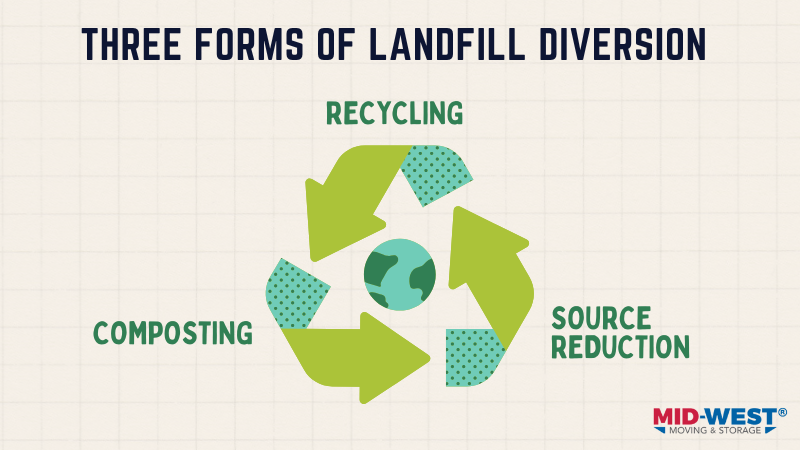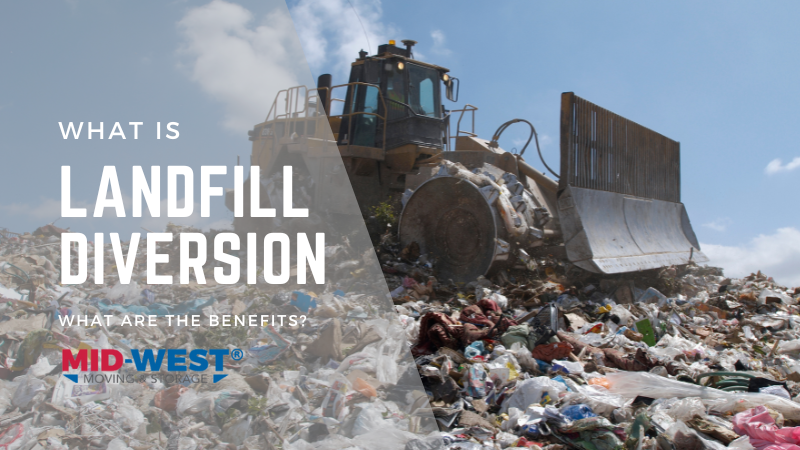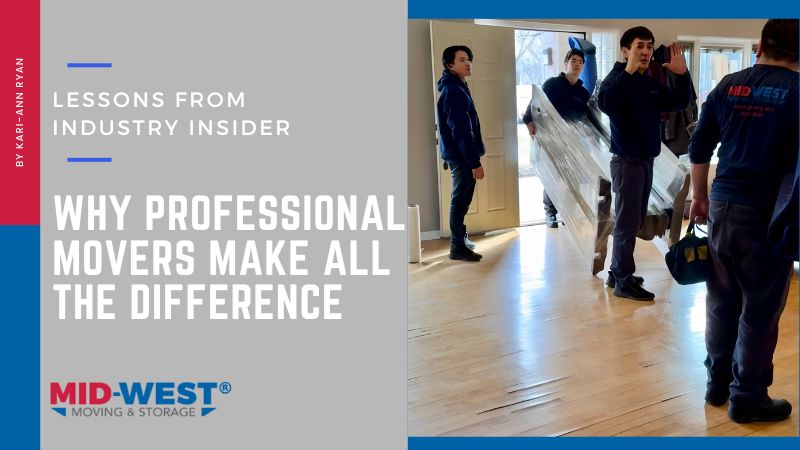Last Updated on October 30, 2024 by Kari-Ann Ryan
Moving to a new home is an exciting endeavor—but one that demands a host of packing materials. Once the relocation is complete, the cardboard boxes and bubble wrap usually end up crowding the landfill. But landfill diversion is a more sustainable way to approach moving.
Each year, approximately 15 million American families relocate to greener pastures. Every residential move creates a massive amount of waste that is dumped into the landfill. This is the reason it is important to use sustainable practices when relocating.
How much waste does moving create?
People use 900 million cardboard boxes annually, tossing most into the trash after moving. Cleaning out the home prior to moving produces 8.4 million tons of junk that is also tossed. In addition to cardboard boxes, Americans discard 90 million pounds of packing paper and 30 million rolls of tape.
What is landfill diversion?
Individuals and families can, however, redirect this waste to prevent it from being dumped into landfills. This process is known as landfill diversion. It is the act of redirecting waste from landfills and instead recycling, composting, or systematically reducing the garbage.
What are the three forms of landfill diversion?
1. Recycling
Recycling items is the most familiar method of landfill diversion. It involves transforming existing products and materials into new forms. Common recyclable materials include aluminum cans, glass bottles, aluminum foil, plastic products, and clean paper and cardboard.
2. Composting
Composting is a second option in landfill diversion and can be done in the backyard. It’s a natural process whereby organic materials decompose, diverting the organic waste from piling up in landfills. Compostable items include food, napkins, paper towels, paper, and cardboard.
3. Source Reduction
Source reduction involves creating less waste in the first place. Individuals and families who utilize this method reduce how much they consume as well as buy well-designed products. For example, people might purchase recycled products and materials, which require less energy.

What are the benefits of landfill diversion?
Landfill diversion benefits the planet in numerous ways. With less waste piling up in the 3,000 active landfills in the US, the lifespan of existing landfills is extended; plus, it postpones the need to create more landfills. These outcomes are key to long-term environmental sustainability.
The demand for new raw materials is reduced by recycling and reusing existing products. In turn, this protects the planet’s limited reserve of natural resources. With the reduced need to extract and produce new materials, energy and industrial pollution decline.
Landfills emit copious amounts of methane gas. The potent greenhouse gas is 23 times more powerful than CO2 emission and contributes to global warming. By composting and recycling, waste is diverted from landfills and reduces the methane emissions and climate consequences.
Individuals and communities also benefit from landfill diversion. The recycling industry creates many jobs in the collection and processing of recyclable materials, thereby contributing to the local economy. Recycling programs engage communities, which leads to a sense of environmental responsibility.
How do individuals support landfill diversion?
1. Swap cardboard boxes for storage bins
Using fewer cardboard boxes when moving is one way to prevent them from ending up in the landfill. Consider using suitcases, bins, and storage containers instead. Rent plastic bins for local moves. Or source free, used cardboard boxes and recycle them after the move.
2. Repurpose junk
The 8.4 million tons of junk Americans discard when moving can be put to use to prevent them from going into the landfill. Hold a yard sale—one person’s junk is another person’s treasure. Donate goods to charities. Long-term, simply buy fewer products (which is easier said than done).
3. Wrap items in blankets instead of packing paper
All the packing paper used during a move keeps breakables safe. However, they should be recycled once their utility has ended. Or rather than using packing paper, rely on soft materials, such as towels, blankets, and pillows to pad belongings. Avoid using packing peanuts and bubble wrap.
4. Use biodegradable tape
After packing items into the hoard of cardboard boxes, they are sealed with large swaths of tape. Use biodegradable tape instead of ordinary packing tape. Or eliminate the use of tape altogether by renting plastic bins with tight lids from local moving supply stores.
5. Recycle
Although the packing process is overwhelming, resist the temptation to automatically throw possessions, like replaceable toiletries and cleaning supplies, into the trash whenever possible. When feeling an urge to toss household goods, consider whether they can be recycled, donated, or repurposed.

6. Donate to food banks
Food waste is another major contributor to landfills. Some organizations, like Move for Hunger, partner directly with moving companies to reduce food waste during moves and redirect them to food banks. Also, plan on buying only essential food items in the weeks leading up to moving day.
Landfill diversion methods are accessible, easy to practice, and help preserve the environment. One local professional mover that is also accessible is Mid-West Moving & Storage. As experienced movers, we help individuals and families relocate to their new home on time and within budget.
Our moving crews are licensed, bonded, and background-checked to deliver peace of mind as they handle your belongings. We protect the home at both the origin and destination with hardwood floor runners, door jamb covers, railing covers, and carpet shield. Furniture is also shrink-wrapped and padded for extra protection.
We also offer a range of comprehensive services for added convenience. Customers have access to our short- and long-term storage facilities. Moving crews are available to pack and unpack your belongings using sustainable packing methods. Our move specialists can create a detailed plan for your move, too.
Mid-West Moving & Storage is the most trusted professional mover in Chicago, Illinois. Serving local residents, we’ll move you in and around the area. Given our years of industry experience, we tackle challenges with ease.
Contact our Elk Grove Village office today at 847.593.7201 to schedule your upcoming move.












